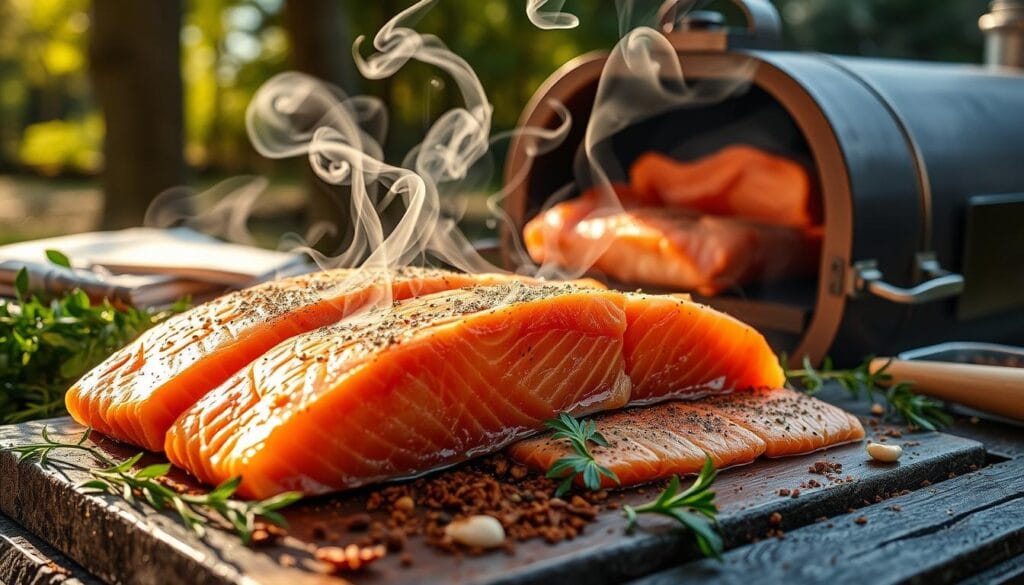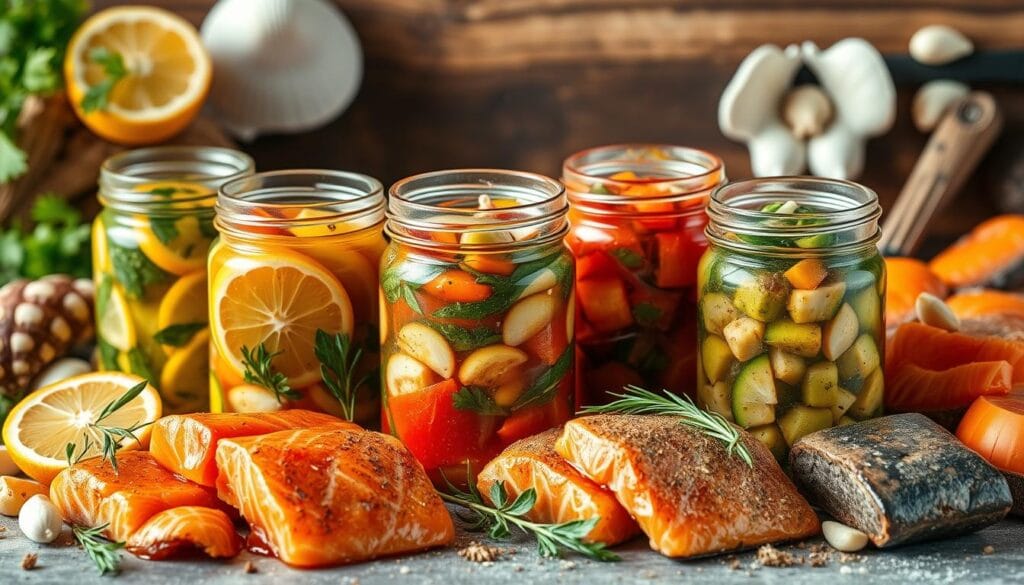Smoked Salmon Brine Recipe: The Secret to Perfectly Flavorful Fish
Smoked salmon brine recipe is a favorite in the United States. It’s known for its silky texture and smoky taste. To make it, you brine, dry, and smoke the fish.
This method keeps the salmon fresh and adds to its taste. It’s also cheaper than buying it in stores. Many people love making it at home.
Table of Contents
Key Takeaways
- Hot-smoked salmon is typically done at around 225°F, while cold-smoked salmon is usually smoked at a lower temperature, around 90°F.
- The fat content in salmon affects its flavor and texture when smoked, with wild king salmon having a higher fat content compared to wild sockeye salmon.
- Brining salmon for 5 hours in a mixture of salt and sugar results in a favorable balance of flavors for smoking.
- High-quality salmon, such as Atlantic or King Salmon, is essential for the best results when smoking due to their size, flavor, and fat content.
- Developing a pellicle by air-drying the salmon in the fridge for up to 24 hours after wet brining helps prevent albumin from escaping and enhances the smoke flavor.
Understanding the Art of Salmon Smoking: Hot vs Cold Methods
Smoking salmon is a tradition that brings out the fish’s natural flavors. You can choose between hot-smoked salmon’s strong smoky taste or cold-smoked salmon’s silky texture. Learning how to smoke salmon is essential for a great taste experience. Let’s look at the differences between hot and cold smoking and how they affect the salmon’s flavor and texture.
Traditional Smoking Methods
Hot smoking and cold smoking are the main ways to make smoked salmon. Hot smoking involves briefly brining the fish and cooking it at 225°F (107°C). This makes the salmon firm and flaky. Cold smoking, however, cures the salmon for a day and smokes it at 90°F (32°C) for 12+ hours. The main difference is that hot smoking cooks the fish, while cold smoking adds flavor without cooking.
Temperature Differences and Their Impact
The temperature difference between hot and cold smoking greatly affects the salmon. Hot-smoked salmon tastes stronger and is firmer. Cold-smoked salmon is silkier and saltier. It’s also important to keep the salmon’s internal temperature between 125°F to 130°F (52°C to 54°C) for the best texture.
Flavor and Texture Variations
The smoking method you pick will change the salmon’s taste and texture. Hot-smoked salmon has a bold smoky flavor and a firm texture. Cold-smoked salmon is softer and has a milder smoke taste. Your choice depends on what you like and the dish you’re making.
“The key to exceptional smoked salmon lies in understanding the nuances between hot and cold smoking methods, and how they can elevate the natural flavors of this versatile fish.”
Choosing the Best Salmon for Smoking
When you’re smoking seafood, the fish quality matters a lot. For the best smoked salmon, pick fillets with the right fat. Let’s look at what to consider when choosing salmon for smoking.
Farm-Raised vs. Wild-Caught Options
- Farm-raised Atlantic salmon is great for smoking. It’s fatty, which keeps the fish moist and flavorful.
- Wild-caught king (Chinook) salmon is also excellent. Its oily texture is perfect for smoking.
- Wild sockeye salmon is leaner. It works well for smoking, but watch it to avoid drying out.
Quality Indicators to Look For
When picking salmon, look for firm, shiny flesh. It should not tear or have fingerprints. Stay away from dull, discolored, or soft salmon. These signs mean it’s not good quality.
Fat Content Considerations
The salmon’s fat content is key for smoking. Fattier fish like farm-raised Atlantic and wild king salmon smoke well. They stay moist and absorb the smoke flavor. Leaner fish, like wild sockeye, might need extra care to prevent drying out.
“The key to exceptional smoked salmon is starting with the highest quality, freshest fish possible.”
Essential Equipment and Preparation Steps
Making tasty homemade smoked salmon at home needs the right tools and prep. You’ll need a smoker or grill, a digital meat thermometer, and brining ingredients.
Start by trimming the salmon and removing bones. Then, mix a wet brine solution. The brining process can take up to 36 hours. You’ll also need a digital thermometer to check the smoker and salmon’s temperature.
- Cure the salmon with salt and sugar for 8-12 hours at room temperature.
- Rinse the cured salmon under cold water to avoid too much salt.
- Dry the salmon on baking racks with a fan for about 12 hours.
- Cold smoke the salmon for 4-5 hours, depending on its size.
- Slice the smoked salmon into strips, vacuum seal, and freeze for later.
The best brine for smoking salmon at home has 1 gallon of water, 2 cups of brown sugar (or honey), and 2 cups of table salt. Marinate the fish in the brine for 45-60 minutes for the best flavor and texture.
| Ingredient | Quantity |
|---|---|
| Water | 1 gallon |
| Brown Sugar (or Honey) | 2 cups |
| Table Salt | 2 cups |
With the right tools and prep, you can make delicious homemade smoked salmon. Adjust the smoking time and temperature for the best results, based on your salmon’s size.
The Perfect Smoked Salmon Brine Recipe
Making perfect smoked salmon begins with a great brine. The brine seasons the fish and makes it firmer. Follow these steps for delicious, flavorful smoked salmon.
Base Ingredients and Measurements
A good smoked salmon brine has water, kosher salt, and sugar. For a 2-pound salmon fillet, you’ll need:
- 32-64 oz (1/4 – 1/2 gallon) of water
- 1/4 cup of kosher salt
- 1/4 cup of white sugar
- 1/4 cup of brown sugar
Optional Flavor Enhancers
For extra flavor, add aromatic ingredients to the brine. Some great choices are:
- Sliced fennel
- Whole black peppercorns
- Juniper berries
- Fresh bay leaves
Brining Time Guidelines
The best brining time is 12-24 hours for flavor and texture. But, you can try different times from 1-7 hours. Longer times make the salmon more seasoned and dense. Shorter times keep it delicate.
Creating the perfect smoked salmon brine is about finding the right balance. With some trial and error, you’ll make an amazing dish.
Creating the Perfect Pellicle: A Critical Step
Making the perfect smoked salmon starts with creating a key part – the pellicle. After brining the salmon, rinse it and dry it in the fridge for up to 24 hours. This drying makes a thin, sticky skin called the pellicle on the salmon’s surface.
The pellicle is crucial for smoking. It helps the smoke stick to the salmon, keeping moisture in and preventing white protein from escaping. A good pellicle is key for the right texture and taste in your salmon curing methods and artisanal fish preparation.
- Rinse the brined salmon fillets and pat them dry with paper towels.
- Place the salmon, skin-side up, on a wire rack set over a baking sheet.
- Refrigerate the salmon, uncovered, for 12 to 24 hours, allowing the pellicle to form.
As the salmon dries, its surface will feel tacky and dry. This means the pellicle is forming. This step is vital for the smoke to stick and keep moisture and flavor in.
“The pellicle is the key to achieving a beautiful, shiny surface on your smoked salmon that will perfectly accept the smoke flavor.”
With a good pellicle, you’re almost ready to make an amazing smoked salmon. It will show off the skill in salmon curing methods and artisanal fish preparation.
Temperature Control and Smoking Techniques
To smoke salmon at home, you need to control the temperature well. The best temperature for smoker recipes is between 180-200°F. This helps the salmon cook slowly and evenly, making it taste smoky and delicious.
The time it takes to cook salmon depends on its size. For a 2-3 lb piece, it can take 1 to 3 hours. Use a digital thermometer to check the internal temperature. It should be between 130-135°F for the best taste and texture.
Wood Selection Guide
The wood you choose for smoking salmon at home affects the flavor. Cherry wood is a favorite, adding a sweet and subtle smokiness. But, you can try other woods like apple, maple, or alder to find your favorite taste.
- Cherry wood: Sweet and subtle smokiness
- Apple wood: Mild, slightly sweet aroma
- Maple wood: Delicate, slightly sweet smoke
- Alder wood: Mild, slightly nutty flavor
For smoking salmon at home, keep the temperature steady and check the fish’s internal temperature. With the right techniques and wood, you can make smoker recipes that everyone will love.

Preventing Common Smoking Mistakes
Making perfect homemade smoked salmon needs focus and knowledge of fish preparation. To avoid common mistakes, here are key tips for flawless smoked salmon every time.
Always use a digital thermometer to check the temperature during smoking. Overcooked salmon can be dry and taste bad. So, keeping the temperature right is key. The best smoking temperature for salmon is between 225°F to 250°F for great flavor and texture.
Don’t rush the smoking process. Slow and low is best for homemade smoked salmon. Cooking too fast can make the salmon look bad. If it looks bad, just scrape off the white stuff with a clean knife, and it’s fine again.
- Use a digital thermometer to monitor temperature and prevent overcooking
- Cook low and slow to minimize albumin formation
- If albumin does appear, simply scrape it off with a clean knife
Also, don’t skip brining and pellicle steps. Brining with salt, sugar, and flavorings makes the salmon taste better and stay moist. Creating a tacky surface called pellicle is important for a shiny finish on your smoked salmon.
By following these tips, you can improve your fish preparation skills. You’ll make delicious homemade smoked salmon that will wow your loved ones.
Storage and Serving Suggestions
Keeping your homemade smoked salmon fresh is key. Store it in an airtight container in the fridge for up to 5 days. If you want to keep it longer, freeze it for up to 6 months. This way, it stays delicious.
To serve your smoked salmon, let it come to room temperature first. This lets the flavors shine. Serve it on bagels with cream cheese, capers, and red onions for a tasty treat. Or, try adding it to scrambled eggs or pasta for something new.
For a fancy touch, put it on a charcuterie board. A squeeze of fresh lemon juice adds a nice zing before serving.
| Smoked Salmon Storage | Serving Suggestions |
|---|---|
|
|

By following these tips, your homemade smoked salmon will stay top-notch. Enjoy every bite of your hard work.
Conclusion
Learning to make homemade smoked salmon is a fun journey. It lets you create dishes as good as those in restaurants, right in your kitchen. By following the steps in this guide, you can make delicious smoked salmon. It will impress your family and friends.
Try different brines, woods, and ways to serve it to make your own special recipe. Smoked salmon is great for many occasions, from casual get-togethers to fancy dinners. With a little patience and practice, your homemade smoked salmon will be amazing.
Whether you’re an experienced cook or just starting, you can now make a smoked salmon brine recipe and homemade smoked salmon. Start exploring the world of smoked salmon. It’s full of tasty possibilities, one delicious bite at a time.
FAQ
What is the difference between hot smoking and cold smoking salmon?
What type of salmon is best for smoking?
What are the essential steps for preparing smoked salmon at home?
What are some common mistakes to avoid when smoking salmon at home?
How should smoked salmon be stored and served?
Tried This Delicious Recipe Yet ?
There are no reviews yet. Be the first one to write one.

